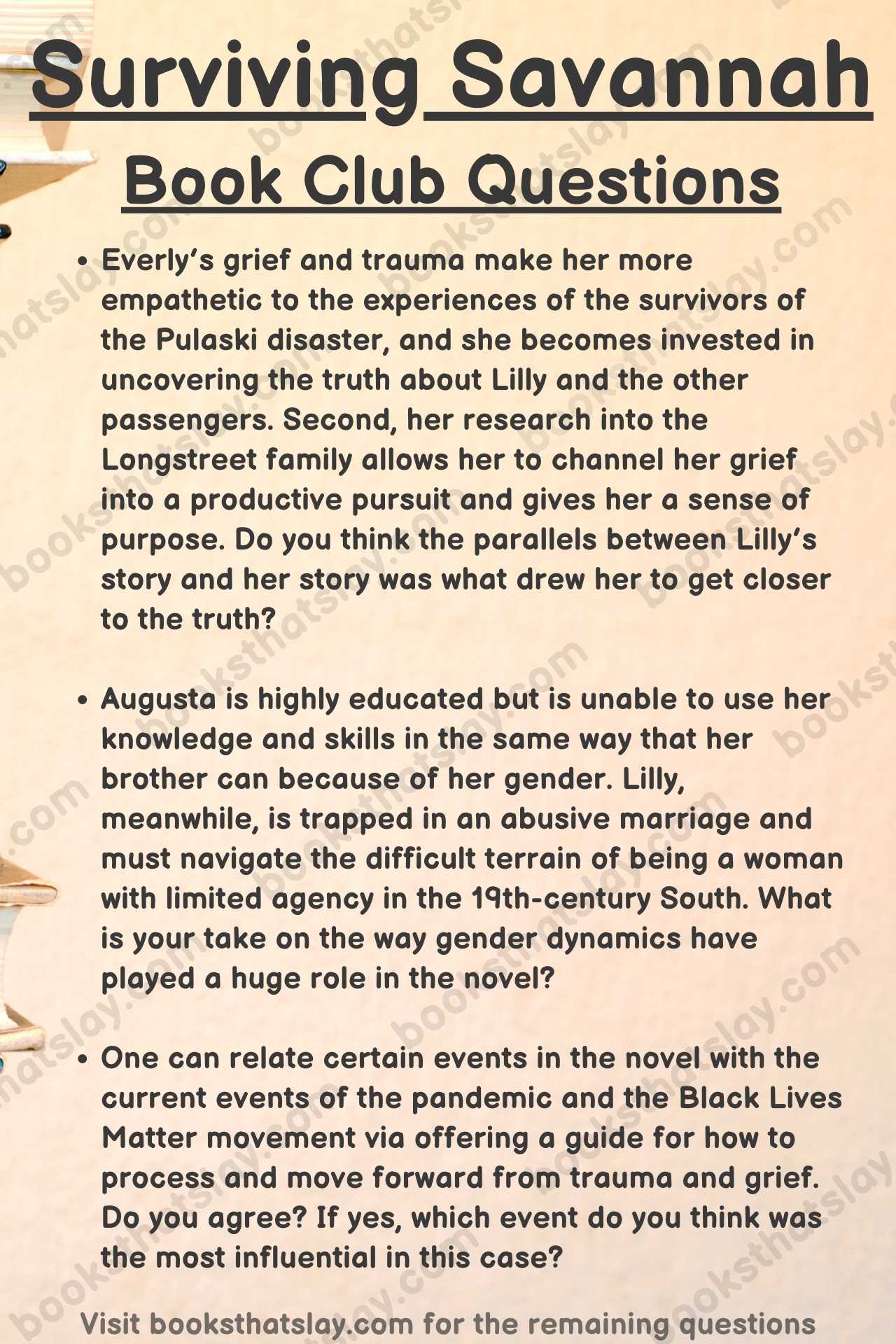10 Surviving Savannah Book Club Questions
Are you drawn to tales of extraordinary courage in the face of adversity?
Do the echoes of the past intrigue you as much as the complexities of the present?
If so, Surviving Savannah by Patti Callahan Henry is a literary journey you won’t want to miss.
This novel transports readers to the core of Savannah, where history professor Everly Winthrop becomes entangled in a web of mystery surrounding the tragic sinking of the Pulaski steamship. Through her meticulous research, Everly uncovers the harrowing experiences of two aristocratic women, their lives irrevocably altered by the disaster.
Join us as we explore thought-provoking questions and uncover the powerful themes that make Surviving Savannah a must-read for those seeking a profound exploration of the human spirit.

Surviving Savannah Book Club Questions
- The historical event that serves as the backdrop for Surviving Savannah is the 1838 sinking of the U.S.S. Pulaski, a ship that was carrying many of Savannah’s elites on a summer voyage up the East Coast. The sinking, caused by an overheated boiler, resulted in the deaths of many passengers, including the novel’s protagonist, Lilly Forsyth.
Discuss how these events affected the novel’s characters and themes by creating a sense of tragedy and loss that reverberates through generations, shaping the lives of those who come after the disaster. Do you think this novel also highlighted how fragile human life is?
- Everly relates to the historical events of the Pulaski sinking through her grandfather’s stories about the passengers, particularly Lilly Forsyth, who was never found. Her research into the Pulaski story leads her on a journey of discovery, both about the historical events themselves and her own personal history of healing from past trauma.
Discuss the character of Everly Winthrop based on her research and analytical skills.
- The novel handles the topic of slavery and its impact on Savannah’s history with sensitivity and nuance. While acknowledging the city’s early wealth was largely built on slavery, the novel also explores the experiences of Black passengers on the Pulaski and their struggle for survival in the face of the disaster.
What’s your take on the way Callahan handled such deep themes and messages with the right amount of sophistication? Also, discuss how she managed to acknowledge the complicated past of the South by not glossing over the uncomfortable truths of history.
- Curating an exhibition about the Pulaski ended up being a challenge for Everly primarily due to the difficulty of finding the necessary Black experience in the historical record. She overcomes these challenges by seeking out new sources of information and collaborating with her Black friend Sophie to create a more complete picture of the disaster.
Do you think it taught Everly important lessons about the importance of empathy, compassion, and humility in the process of historical inquiry?
- One can relate certain events in the novel with the current events of the pandemic and the Black Lives Matter movement via offering a guide for how to process and move forward from trauma and grief.
Do you agree? If yes, which event do you think was the most influential in this case?
- The novel shows that survival is not always a straightforward path and that it can be a struggle to find meaning and purpose in the aftermath of a traumatic event. Lilly and Augusta, the two main characters from the 19th-century timeline, both survive the disaster and are forced to confront their own biases and prejudices as they struggle to survive at sea. In the modern-day timeline, Everly is dealing with her own personal tragedy and uses her research into the Longstreet family as a way to cope with her grief and find some sense of closure.
Discuss.
- The setting of “Surviving Savannah” is similar to that of the Titanic in that both disasters involved luxury ships that sank, resulting in the loss of many lives. However, the Pulaski steamship disaster is less well-known than the Titanic, especially outside of the Southern United States. Callahan uses the Pulaski disaster as a way to shed light on a piece of history that is often overlooked while also exploring themes of privilege, class, and gender in the 19th-century South.
Do you agree with this comparison?
- Augusta is highly educated but is unable to use her knowledge and skills in the same way that her brother can because of her gender. Lilly, meanwhile, is trapped in an abusive marriage and must navigate the difficult terrain of being a woman with limited agency in the 19th-century South.
What is your take on the way gender dynamics have played a huge role in the novel?
- Everly’s grief and trauma make her more empathetic to the experiences of the survivors of the Pulaski disaster, and she becomes invested in uncovering the truth about Lilly and the other passengers. Second, her research into the Longstreet family allows her to channel her grief into a productive pursuit and gives her a sense of purpose
Do you think the parallels between Lilly’s story and her story were what drew her to get closer to the truth?
- Callahan uses a braided narrative structure to connect the past and present in her novel, with Everly’s modern-day storyline intersecting with the historical narrative of the Pulaski disaster. The braided structure allows Callahan to explore the ways in which the past informs the present and the legacy of historical events on contemporary society
Do you agree?
If you liked this set of questions, here are some other options for you to explore.